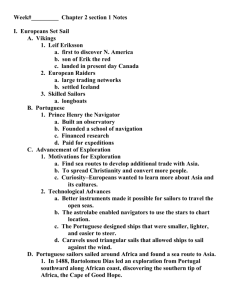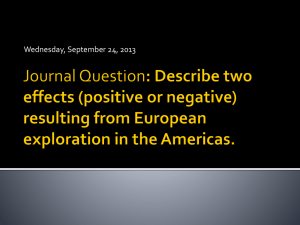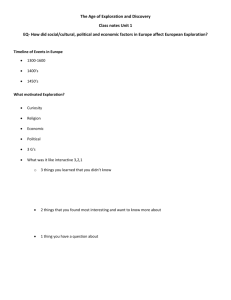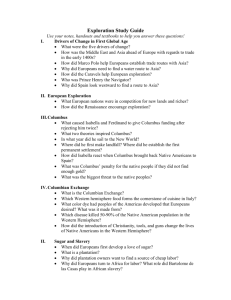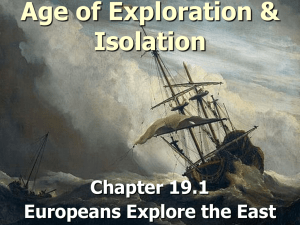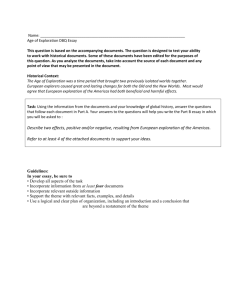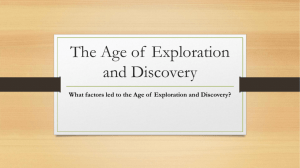Introduction to the New Voyages of Discovery
advertisement
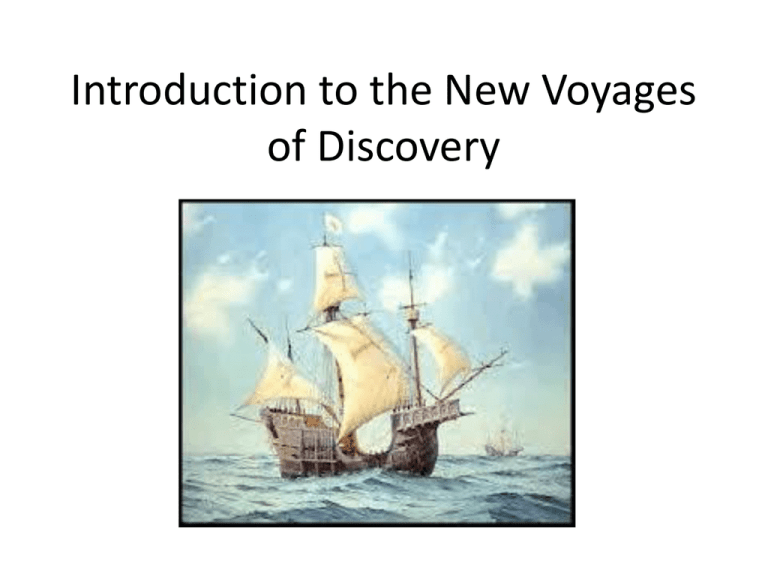
Introduction to the New Voyages of Discovery Statement 1 • 1. Christopher Columbus was the first explorer to cross the Atlantic Ocean. TRUE or FALSE? FALSE! 980- 1010 A.D Vikings crossed the Atlantic Statement 2 • 2. The Spanish conquered the Aztec and Inca Empires (modern day Mexico and South America). TRUE or FALSE? TRUE! • The Spanish Conquistadors conquered the great civilizations of the Aztecs and Incas. Statement 3 • 3. Europeans invented the compass and astrolabe. • TRUE OR FALSE??? FALSE! • The Chinese Invented the Compass • The Arabs invented the Astrolabe Statement 4 • 4. The Portuguese were the first Europeans to explore the world in ships. • TRUE OR FALSE??? TRUE! • Civilizations such as the Vikings and Chinese had maritime technology long before the Europeans. • However, the Portuguese were the first “Europeans” to do so. Statement 5 • 5. Columbus discovered America. • TRUE OF FALSE???? FALSE!!!! • Columbus never set foot on American Soil. • Also, Native Americans had been in America for thousands of years before him!! Statement 6 • 6. “America” is named after an Italian merchant and navigator “Amerigo Vespucci.” • TRUE OR FALSE??? TRUE!!! Amerigo Vespucci Statement 7 • 7. Ferdinand Magellan was the first person to “circumnavigate” the world, or sail around the world. • TRUE OR FALSE???? TRUE!! • Ferdinand Magellan was the first person to “circumnavigate” the world, or sail around the world. Statement 8 • 8. Christopher Columbus died believing he had discovered trade routes to China (he never knew he discovered the “new world”). • TRUE OR FALSE???? TRUE!!!! • Christopher Columbus believed he found China and Japan!!! Statement 9 • 9. Christopher Columbus enslaved thousands of natives in the Bahamas, Cuba, and modern day Haiti and Dominican Republic. • TRUE OR FALSE TRUE! • Christopher Columbus enslaved most of the natives in the countries he discovered. He often treated these people violently and brutally. Statement 10 • 10. Sailors often died of Scurvy, which is a disease caused by lack of Vitamin C (from fruits). • TRUE OR FALSE??? TRUE! • Your body needs vitamin C to live. Fruit could not last very long at sea and and sailors went months without fresh fruit, which led to Scurvy! Statement 11 • 11. Sailors often ate food infested with maggots (baby flies) and other insects. • TRUE OR FALSE???? TRUE!!! • They didn’t have refrigeration back then, and poor storage of food. Rats and insects got into their food and they had to eat it or they would starve! Statement 12 • 12. Most Native Americans were violently killed by the Spanish Conquistadors. • TRUE OR FALSE??? FALSE!!! • Although thousands were brutally killed by the Spanish Conquistadors most native Americans died from Smallpox. A disease the conquistadors didn’t know they carried with them. Statement 13 • 13. The Gold from the Aztec and Inca empires made Spain extremely rich. • TRUE OR FALSE!!! TRUE!!! • The Conquistadors brought back tons of gold from Mexico and south America. Europe Enters the Modern Age Objective: Students will analyze the motives and technology that allowed the age of exploration come to pass. The Age of Exploration Age of Exploration: a period of European exploration and discovery that lasted from about 1418 to 1620 Think, Pair, Share A period of European exploration and discovery that lasted from about 1418 to 1620 is referred to as… The Age of Exploration. Terms to know Motives: something that causes a person or people to act. Cartography: the science and art of making maps. Circumnavigate: to sail all the way around the world. At the same time that Europe was swept up in the Renaissance, Scientific Revolution and the Reformation, other major changes were taking place in the world. These changes originated in Europe, but soon involved other continents. The changes began with a series of voyages during the 1400s, 1500s, and early 1600s when European explorers ventured into the Atlantic and Pacific oceans. With today’s global positioning satellites, Internet maps, cell phones, and superfast travel, it is hard to imagine exactly how it might have felt to embark on a voyage across an unknown ocean. Think/Pair/Share: Would you be willing to undertake such a voyage? Only those most adventurous, most daring, and most confident in their abilities to sail in any weather, manage any crew, and meet any circumstance dared do so; for not having those qualities meant certain death. Whiteboards To sail all the way around the world is referred to as… Circumnavigation Something that causes a person or people to act is... Motives The science and art of making maps. Cartography European explorers changed the world in many dramatic ways. Because of them, cultures divided by 3,000 miles or more of water began interacting. European countries claimed large parts of the world. As nations competed for territory, Europe had an enormous impact on people living in distant lands. The Americas, in turn, made important contributions to Europe and the rest of the world. For example, from the Americas came crops such as corn and potatoes, which grew well in Europe. By increasing Europe’s food supply, these crops helped create population growth. Whiteboards From where did the Age of Exploration begin? From Europe Name 2 items that came from the New world to Europe?. 1. Corn. 2. Potatoes Which oceans were involved and were they underestimated by the navigators? 1. The Atlantic The Pacific 3. They were woefully underestimated. The Causes of European Exploration Two main reasons stand out. First, Europeans of this time had several motives for exploring the world. Second, advances in knowledge and technology helped to make the Age of Exploration possible. • For early explorers, one of the main motives for exploration was the desire to find new trade routes to Asia. Europeans were especially interested in spices from Asia. • Trade with the East, however, was difficult and very expensive. Muslims and Italians controlled the flow of goods. European monarchs and merchants wanted to break the hold that Muslims and Italians had on trade. A final motive for exploration was the desire to spread Christianity beyond Europe. Advances in Knowledge and Technology A number of advances during the Renaissance made it easier for explorers to venture into the unknown. One key advance was in cartography, or mapmaking. Discoveries by explorers gave mapmakers new information with which to work. In 1507, a German cartographer made the first map that clearly showed North and South America as separate from Asia. In turn, better maps made navigation easier. Whiteboards What was a main motive for European exploration? A. Finding spices from the Americas. B. Finding new trade routes to Asia. C. Finding people who could make better ships. D. Finding foods that would not spoil on long voyages. B. Finding new trade routes to Asia. Whiteboards Caravels • An improved ship design also helped explorers. By the 1400s, Portuguese and Spanish shipbuilders were making a new type of ship called a caravel. • These ships were small, fast, and easy to maneuver. Their special bottoms made it easier for explorers to travel along coastlines where the water was not deep. • Caravels also used lateen sails, a triangular style adapted from Muslim ships. These sails could be positioned to take advantage of the wind no matter which way it blew. The Caravel Along with better ships, new navigational tools helped sailors travel more safely on the open seas. Sailors used compasses to find their bearing, or direction of travel. The astrolabe helped sailors determine their distance north or south from the equator. Finally, improved weapons gave Europeans a huge advantage over the people they met in their explorations. Sailors could fire their cannons at targets near the shore without leaving their ships. On land, the weapons of native peoples often were no match for European guns, armor, and horses. Whiteboards Which of these is an advance in knowledge and technology that led to European exploration? A. A desire to spread Christianity. B. A chance to earn wealth from new lands. C. Improved ship design D. Merchants who wanted to increase trade. C. Improved ship design End of Part I

